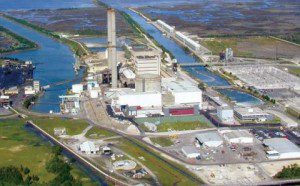A consulting firm says repairing Progress Energy’s shut down Crystal River nuclear plant is technically feasible, but would cost a minimum of just under $1.5 billion, assuming no additional damage is done.

The company, a subsidiary of Duke Energy, notified regulators on Monday of the report’s conclusion and said it hasn’t decided whether to fix the plant or shutter it for good.
The highly anticipated independent consultants’ report from Zapata Inc., found that a number of “significant risks” were involved in repairing the facility and that technical issues still needed to be resolved.
The Crystal River plant has been shut down since 2009, when a containment building was damaged during a project to replace a steam generator. Then last year, as the company was preparing to start it up again, additional damage was found in a different part of the building.
Zapata also projected a “worst-case” scenario of how high the cost could go in the event that additional damage is done as the company moves to repair the earlier problems, and said the possible high end for such a repair could run to $3.43 billion and take 96 months to complete.
The more likely $1.49 billion cost estimate – with a schedule of 35 months – is still higher than Progress’ earlier projection of $900 million to $1.3 billion, due to what the company said was an increase in the scope of repairs needed. Duke CEO Jim Rogers had warned the state Public Service Commission back in August that estimates were “trending up” and likely to be higher. The company also said the cost was likely to go up when it released its quarterly financial statement in early August.
“The scope of work proposed … is feasible, but there are risks associated with the technical approach, construction methodology, scheduling and licensing,” Charlotte, N.C.-based Zapata said in its report. “Those risks have cost implications that make it problematic to project an actual construction cost.”
Duke bought Progress earlier this year, completing the acquisition in July.
“We have not made a final decision on whether to repair or retire (the facility)” incoming Progress President Alex Glenn said in a statement announcing the company had filed the consultant’s report with the PSC. “The decision and schedule will be driven by the final analysis, not vice-versa. The evolving analysis also will provide increasing detail on cost and schedule expectations….
“….We will proceed with a repair option only if there is a high degree of confidence that the repair can be successfully completed and licensed within the final estimated costs and schedule, and is in the best interests of our customers, joint owners and investors,” Glenn said.
Some of the questions raised by the consultants that could ultimately affect whether the repair can be done at the lower end of the cost spectrum include whether the dome on the containment building will be damaged during the repairs of the walls. If the dome has to be removed the cost would go up and it would take longer, the consultants said.
Progress officials have said that if they decide to go forward with a repair, work could start within three months, but Zapata said planning doesn’t appear to be sufficiently detailed yet to allow for that quick of a start, and that it would more likely be six to nine months before actual work could begin.
It the company decides to go forward, URS Corp. would do the work.
St. Petersburg-based Progress Florida is the second largest electric utility in the state behind Florida Power & Light. Progress has about 1.6 million Florida customers.
By David Royse


